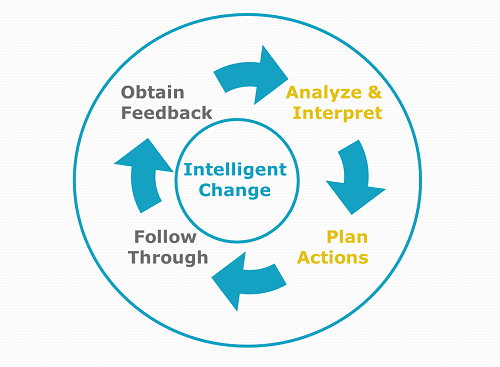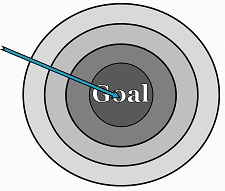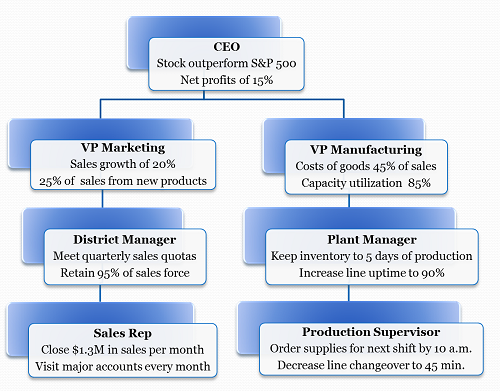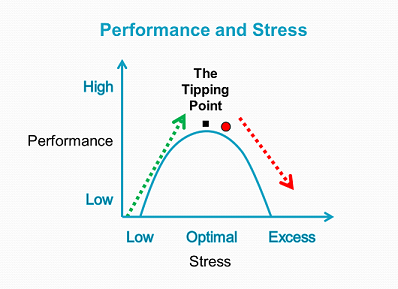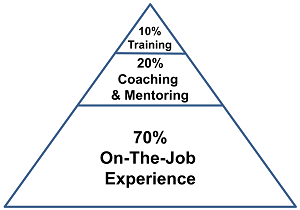When you walk in the room, who shows up for Read more →

Practicing Leadership Skills in Safety
Leaders trying out new skills can pose problems to their organization. Sometimes the new skills work perfectly from the start. Sometimes these skills create problems for the people around the leader. So how can leaders master the skills they need with minimum risk of collateral damage?
My fifteen year old son has his learner’s permit. To new drivers, this permit represents a bright future full of freedom. But this new freedom requires mastering five thousand pounds of steel and gasoline hurtling through traffic. On my learner’s permit, I rear-ended a parked Buick and slammed it into a Cadillac. Just like leaders in business, new drivers must master new skills with minimum risk of collateral damage.
Our teenage drivers start in a parking lot. The parking lot is a safe place to practice steering and stopping before going on the road. After a few sessions circling the lot, I up the stakes by adding orange cones and paper cups. I challenge my new driver to miss the cones and crush the cups.
The driver accelerates to 15 miles per hour and then attempts to crush a specific cup. They get immediate feedback from the crushing sound and the view in the review mirror. They also get positive reinforcement – praise for a job done well. And, with the orange cones absorbing the punishment of right side errors, the public remains safe.
Leaders should master skills as safely as possible. A well designed leadership development program creates a safe place to practice skills. There should be immediate feedback and lots of praise for success. Failure should impact orange cones instead of actual careers.
I recently created a leadership program to help leaders manage emotions. For realistic practice, the leaders had to experience extreme emotions – fear, vigilance, exhilaration – that can hijack a leader who is driving change, challenging an unethical decision or giving a presentation.
Obviously, we would not create these emotions by putting people’s careers at risk. Instead, we had participants do a high ropes course. They climbed trees, jumped into space and took a zipline across a lake. Real emotions, but in a safe environment. Practice managing those emotions, but nothing worse than freezing up while climbing or declining to jump.
How did it turn out? Every participant mastered the zipline. Almost every participant reported fear, exhilaration or other intense emotions. And many successfully used the skills taught in the classroom to manage their emotions.
The next Sunday, I took my son out driving in the parking lot. He crushed his cups too.
And no collateral damage was recorded, on the zipline or in the parking lot.

Bottom line: As a leader, take appropriate risks. Develop new skills by practicing in safety first.
Before the big presentation, practice with a video camera first, then debrief the video with a leadership coach.
Before a difficult conversation, work with your coach to get the details right.
Before a job interview, practice your stories with your circle of trusted advisors.
Practice until you crush the cups and miss the cones. And, you won’t rear-end any Buicks.
Images of Goals and Metrics
From my blog posts on goal setting for leaders.
.
.
.
.
Management by Objectives? Or Leading with Goals?
.
.
.
.
.
.
.
.
.
Spoiling Good Goals with Bad Metrics
.
Good Goals Gone Bad
Goals are powerful leadership tools that focus attention and effort. Good goals go bad when their power blinds us to critical information or strategic changes.
Good Goals
As a leader, goal setting is an essential part of your leadership toolbox. Like any tool, you have to use goals right:
Set SMART goals. Smart goals are specific, measurable, actionable, realistic and time-bound. Part of being realistic is making sure none of your employees have too many goals.
Coordinate goals. Use management by objectives to ensure goals are coordinated between people and organizations.
Provide metrics. Create goal-specific metrics to further shape and refine behavior.
If your goals are SMART, coordinated and backed by metrics, you will have a powerful leadership tool.
With great power comes great responsibility, for Spiderman and for leaders. The very power of goal setting can create problems. In my post on Got a Goal? Get A Metric! I used a photo of my power saws to illustrate the idea of goals as powerful tools.
My gloved hand is reaching for my zip saw in this picture. I love my zip saw – it is fun, powerful and fast. I also loved those gloves. Loved, because I no longer have those gloves. A day or so after David Slade took this picture, I got careless and touched the moving blade with my gloved hand. I was not injured, but the finger tip of one of my gloves was destroyed. Goals are like my zip saw – powerful, effective and potentially dangerous.
Goals Gone Bad
Here are two example of goals gone bad:
Counting Basketball Passes. Watch this video carefully and attempt to follow the directions. Done? Spoiler alert: If you haven’t watched the video yet, please do so. Most people are so focused on the goal of counting basketball passes that the gorilla goes unnoticed.
In an organization, people can get so busy meeting their goals that they miss the gorilla. A sales person gets focused on meeting their quota, and customer service goes south. A plant manager focuses intently on production and cost goals, and maintenance slips. A general manager focuses on the profit goal and doesn’t notice that employees are burning out. The gorilla – poor customer service, delayed maintenance or employee burnout – can destroy the organization, but leaders do not even notice the gorilla in the room because of their laser-like focus on meeting their goals.
Climbing Mount Everest. On May 11, 1996, a number of people were attempting to fulfill their goal of climbing Mount Everest. Climbers were intensely focused on reaching the summit. When the climbers faced delays on the ascent, they ignored declining oxygen supplies and a gathering storm to push through to meet their goal. Eight people died that day on Mount Everest. Jon Krakauer blamed a number of factors for the deaths, but one powerful factor was destructive goal pursuit. Individual climbers had planned and trained for years. Deciding to turn back would have meant giving up that cherished goal. The expedition companies competed with one another for clients. They also had an intense commitment to the goal of having clients summit Everest.
Relentless pursuit of business goals can lead to death. Auto companies pursuing low costs produce unsafe cars such as the Corvair, Pinto and Explorer. Construction companies taking short cuts on safety practices to meet project deadlines. Truckers fall asleep at the wheel attempting to make just-in-time delivery goals.
In most organizations, no one dies from relentless pursuit of goals. Instead, goal focus creates short term success and long term loss. The goals are met, but the organization alienates customers, employees or vendors.
Avoiding Goal Blindness
In both the basketball video and the fatal Everest climb, the power of the goal blinded participants to vital information. If goals are powerful, their power must be moderated. In other words, leaders are responsible for using goals wisely. Here are a couple of thoughts on how to limit the destructive power of goals:
Lead with principled moderation. As a leader, you need to be a rock in the storm. You have to take a principled stand. In my post on the leadership paradox of principled moderation, I suggest integrity and appropriate transparency as two non-negotiable leadership principles.
Take a look around. An antidote to the focusing power of goals is to shift your focus. Take your eyes off the goal at hand and look to the horizon. Encourage your people to do the same. Pause. Take a breath. Ask powerful questions: “Are we doing the right thing? How does this impact our customers? Employees? Community? Five years from now, will this still seem like a good idea?”
Resource properly. When people are tight on time, energy, supplies or people, they have to push harder to accomplish their goals. Pushing harder makes goal blindness more likely. The basketball video tricks most first time viewers because you have to really focus to get the count right. The Everest climbers had limited endurance and bottled oxygen to make the climb in a narrow window of time. A little more time, a few more supplies or an extra person can help you and your team avoid the tipping point of performance and avoid goal blindness.
Bottom line: Goals are powerful. Use them wisely and take precautions to avoid goal blindness. Then, you can keep your good goals from going bad.
Too Many Goals?
Goals are powerful leadership tools. They focus attention and effort on the key accomplishments needed for organizational success. If goals are good, are more goals better? As a leader, how many goals should you set?
Basics of Goal Setting
As a leader, goal setting is an essential part of your leadership toolbox. Like any tool, you have to use goals right:
Set SMART goals. Smart goals are specific, measurable, actionable, realistic and time-bound.
Coordinate goals. Use management by objectives to ensure goals are coordinated between people and organizations.
Provide metrics. Give goal-specific feedback to further shape and refine behavior. I will discuss metrics more in my next post.
No Goals are No Good
Leadership is managing energy in yourself first and then in others. Goals help you manage energy. Goals provide a destination for efforts. They give direction and quantity for work related behaviors. If you have no goals, your own efforts will be unfocused. And if you do not set goals with your team, their efforts may be unfocused also, or their efforts may be focused on things that do not contribute to the organization’s success.
Too Many Goals
Goal setting is good, but be careful. Too many goals can backfire. The key benefit of a goal is to focus energy. More goals create more focal points. Like a busy instrument panel, too many goals can confuse and distract rather than focus attention.
So, how many goals is too many?
More than three goals is the same as no goals. When a client asks how many goals to set, I use this simple rule of thumb as a starting point.
A simple rule of thumb is better than nothing, but principles of leadership are outdated. Here are more refined ways to think about the maximum number of goals.
More goals with experience. An experienced pilot shouldn’t have trouble making sense of a plane’s control panel. An employee with years of good performance can handle more than three goals.
More goals with phased timing. If you have a complex project, a project plan might have dozens or hundreds of task goals. So long as your employee understands the project plan, the number of goals will not be an issue.
More situational goals. Some goals are relevant only in certain situations. For a retail business, you might have a SMART goal about customer wait times. If customers are not waiting, that goal is not triggered. You can have other goals about stocking or cleaning that are triggered in other situations.
In other words, the maximum number of effective goals depends on the situation your employee faces. To really know how many goals, you should have an ongoing dialogue about goals with your employees.
Goal setting. At the beginning of the performance cycle, set goals participatively. Get your employee’s sense of what is realistic.
Goal performance. While the goals are in place, keep the conversation going. Get to know their work pace and their motivations. Adjust goals as needed, whether it is the type of goal, the level or the number of goals.
Goal review. At the end of the performance cycle, evaluate performance against goals. And also evaluate the goals themselves. Ask how the goals helped or hindered performance. And be open to correcting your missteps in setting goals or supporting your employee’s performance.
Throughout the goal cycle, keep the conversation going. And, make it a dialogue. Actively listen as much as you speak.
Bottom line: Know how many goals is too many. Understand the situation each employee faces and work with them to set a realistic number of goals. And, if you have created too many goals for an employee, back off. Prioritize and consolidate goals to get the right number of goals. You will help your employees focus their attention and increase their performance.
Images of Active Listening
From my series of blog posts on active listening for leaders.
.
.
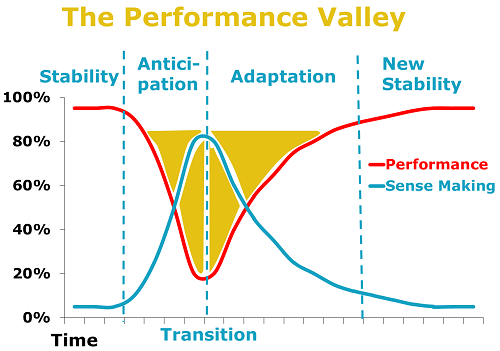 Listening in the Performance Valley
Listening in the Performance Valley
.
Energy for Active Listening
Leaders who listen well are more effective, more persuasive and more engaging than leaders who don’t listen. Carol Wilson¹ lays out five levels of listening:
1. Interrupting
2. Sharing
3. Advising
4. Attentive Listening
5. Active Listening
We have thought about Levels 1-4 in previous posts.
- You’re not listening if you’re interrupting, sharing or advising (Levels 1, 2 or 3).
- Attentive listening (Level 4) can be effective, especially in the midst of change.
Today, let’s complete the set by looking at active listening (Level 5) in more detail.
5. Active Listening
“I had the worst meeting with my boss today.”
“What happened?”
“She tore apart my financial report. I was embarrassed in front of everyone.”
“That must have been difficult.”
“You don’t know the half of it.”
“Has this happened before?”
. . .
“Why do you think she reacts that way?”
. . .
“Have you thought about what you can do?”
Active listening takes your leadership to the next level. Like attentive listening, you are focused on the other person and what they say. But you are adding more breadth and depth to the conversation. I define active listening as “the art of listening with intensity to truly hear what the other person says, knows and feels.”
The conversation about the meeting disaster gets to the heart of the issue. The other person’s feelings are validated with the reflective statement “That must have been difficult.” Causality is explored with the “Why?” question. And the other person’s problem solving is activated by asking “What can you do?”
Just the Facts?
Both attentive listening and active listening are powerful and effective tools for a leader. Both focus on the other person and help them make sense of their situation.
So what’s the difference? For me, attentive listening focuses primarily on the facts of the situation. An attentive listener asks “Who? What? Where? When?” Active listening goes beyond the facts to get to reactions and feelings. Active listening consciously explores causal factors and engages the problem solving capabilities of the other person. An active listener asks “Why? How? What’s next?”
Attentive listening focuses on the words of the other person. The active listener goes beyond just the words to notice tone, facial expression and body language. Carol Wilson describes active listening as “listening behind the words and between the words; listening to the silences; using your intuition; promoting the coachee to explore; facilitating the coachee’s self learning and awareness; making suggestions.”
If attentive listening can help shrink a performance valley, active listening is even better. When you actively listen, you have a greater opportunity to address feelings, explore causes and get the other person to solve their own problems. Then, you maximize their sense-making in the midst of change and help them get back to peak performance sooner.
Managing Your Energy
Active listening is powerful and effective. That power comes from your intensity and focus. But expending that level of power can drain your battery.
Bottom line: Active listening is hard. In a classroom exercise, I ask my students to actively listen for seven minutes. Maybe one student in thirty can actively listen for seven minutes.
Don’t be discouraged if you have trouble staying in active listening mode. Like most leadership skills, you can improve your capacity for active listening with practice. If you’re new to active listening, start small. Try this mini-experiment:
- Find someone who needs to talk. Then listen as intensely as possible for ten minutes. Notice how much time you spend in interrupting, sharing, advising, attentive listening and active listening.
- Repeat with another 10 minute listening session. Try to increase your time in active listening. It’s ok to dip into attentive listening, but minimize your interrupting, sharing and advising. Again, notice how much time you spend in each listening level.
- Keep looking for listening opportunities, gradually increasing your proportion of active listening. Then, plan to listen for 15 minutes.
With enough practice, you can achieve 50-70% active listening for an hour.
If you’re already competent at active listening, I encourage you to listen more and better. Increase your active listening capacity like a miler training for a marathon. My mini-experiment in active listening has been going for years. After every coaching session, I still do a self-evaluation of my listening. I am getting better, but I still have a way to go.
Novice or expert, practice will build your listening capacity. And, if you listen carefully, you may notice a few performance valleys shrinking.
______________________
¹Carol Wilson, “Tools of the Trade” Training Journal, July, 2010, pp. 65-66.
You’re Not Listening
Active listening is a key skill for leaders. In a previous post on Two Steps to Active Listening, I defined active listening as “the art of listening with intensity to truly hear what the other person says, knows and feels.” Leaders who actively listen are more effective, more persuasive and more engaging than leaders who don’t actively listen. It is good to know what active listening is. It is also good to know what active listening is not. Let’s look at other ways to listen.
Carol Wilson¹ lays out five levels of listening:
2. Sharing
3. Advising
4. Attentive Listening
5. Active Listening
The first three levels don’t contain the word “listening” for good reason: When you’re interrupting, sharing or advising, you’re not listening.
Levels 4 and 5 are truly listening, and we will talk about them in a later post. Today, let’s look at levels 1, 2 and 3.
1. Interrupting
“That really didn’t go well. I am worried about . . .”
“Did you see the game last night? The officiating was awful.”
When you interrupt, you build yourself up at the other person’s expense. In effect, you are saying “Be quiet because what I have to say is more important.”
How often do you interrupt others? Maybe you are rushed, anxious or annoyed. Maybe the other person has raised a topic you want to avoid. Whatever the reason, you drain energy by stepping on their airtime. A little patience, a bit of deference and a dose of etiquette will make you a better listener and a better leader.
2. Sharing
“My boss always takes credit for my work. It’s just not fair.”
“Yeah, he did the same thing to me. I made this killer presentation, but he just put his name on it and presented to the vice-president.”
With sharing, when someone shares their experience, then you share a similar experience. You may think you are reinforcing their experience, but you are really minimizing their unique situation. When the other person is speaking, you are focused on preparing your response. In other words, you are silent but not listening too hard.
When you appear to be listening, are you just waiting your turn? Do you value your experiences more than the experiences of the other person? Serve the other person by focusing on their story – your story can wait.
3. Advising
“I get really nervous when I present to the Design Group. Sometimes I shake like a leaf.”
“Try practicing in front of a mirror.”
As an accomplished professional, you have experience, expertise and insight. When someone presents you with a problem, it is easy to shift into problem solving mode.
As a problem solver, listening is critical to help you diagnose the situation so you can provide the best solution. However, it is tempting to listen only enough to figure out the problem. If your default listening mode is advising, then listening can come across as a necessary evil rather than a worthy pursuit.
Problem solving is a good thing. The problem with problem solving is we use it too much and we use it too soon. We present solutions when the other person needs dialogue. We jump to solutions instead of deep-diving issues, understanding values and exploring causality.
If someone presents you with a problem, do you quickly offer a solution? Do you listen just enough to be confident in your solution? Listen more – it will lead to better solutions. Listen longer – the other person may solve their own problem. Listen better – it will show you care.
You’re Not Listening
Interrupting, sharing and advising have two common roots. The first root may be your self-confidence. You value your own experiences, insights and problem solving capability. However, your self-confidence may bulldoze the other person’s need to be heard.
The second root may be your lack of confidence in the other person. Their conversation may show immaturity. Their wisdom seems lacking. They, after all, have come to you. If you lack confidence in them, it logically follows that you will talk more so they will talk less.
Whether you suffer from too much self-confidence or too little confidence in the other person, the end result will be too little listening on your part and too much interrupting, sharing or problem solving.
Listening Starts With Humility
The best listeners are humble. They value the other person highly. They have patience because they know the other person has important things to say. The best listeners serve by having more questions than answers. And, they would rather help the other person solve their own problems.
Notice how you listen. Notice when you shift to interrupting, sharing or problem solving. If your interruption, your story or your solution does not serve the other person, then I will give you Bob Newhart’s classic advice: stop it.
Instead, take the two steps to active listening: be quiet and value the other person. You may find the resulting dialogue leads to better insight, better solutions and a better relationship.
______________________
¹Carol Wilson, “Tools of the Trade” Training Journal, July, 2010, pp. 65-66.
Two Steps to Active Listening
Listening skills are critical for leaders. Listening opens the channels for two way communication. And it is not enough to simply be present when others are talking. You must engage in active listening, the art of listening with intensity to truly hear what the other person says, knows and feels.
I have coached b-school students, change management clients and leadership coaching clients on how to listen better. Based on those experiences, here are two steps for active listening.
1. Be Quiet
The first step to active listening is simple. Stop talking. Let the other person speak without interruption or comment from you. Surprisingly, this step is often the hardest, especially for people who are smart, driven and successful.
Sometimes we act as if silence implies consent. When someone says something wrong or they focus on unimportant aspects of the issue, we want to jump in to set things right. But you can hear without necessarily agreeing. Like a reporter interviewing politicians or a researcher gathering consumer opinions, you might not agree with what is being said, but you can stifle your impulse to speak in order to truly understand the other person’s point of view.
There is another reason to be quiet. Silence is power. In most social situations, we expect talking to fill every moment. Your silence implies personal control. Being silent means you are confident and comfortable. If you can be quiet, the other person may feel compelled to fill the uncomfortable silence.
2. Focus on the Other Party
The point of active listening is to get the other person’s perspective. To do that, you must focus on them – completely.
Use reflective listening. Repeat and paraphrase what you hear. Use phrases like “I hear you saying…” or “It sounds like…” Ask questions of clarification like “Why do you think that happened?” “When did she first say something?” or “How did that work out?” Summarize their key points. When they have given you lots of facts and reasons, try to draw out the themes. And be tentative, always checking with them to see if you understand what they are trying to say.
But it is not enough to listen to the other person’s words. You must also watch their non-verbal communication. Watch facial expressions, tone of voice and body language. Check your observations by using the phrase “You seem to feel . . .” It is especially important to notice when their words and their non-verbal communication seem to be at odds. For example, if the other person tells you they fully support a certain decision (while their eyes are downcast, their voice has no energy and their posture is slumped), follow up to see if there are some unspoken concerns.
A Difficult Conversation
Suppose you need to have a difficult conversation with someone. You may need to discuss a broken commitment, call out unacceptable behavior or give feedback on poor performance. While you might think talking more increases your chance of persuading them, you might be surprised by the power of active listening. The best difficult conversations follow this pattern:
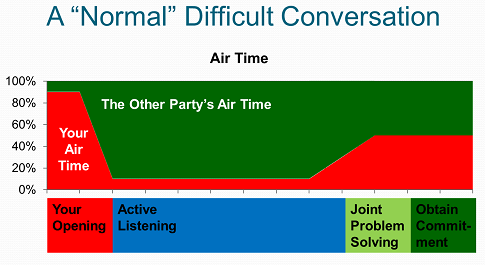 Active listening is central to this difficult conversation. By being quiet and focusing on the other party, you are helping move them toward joint problem solving and commitment. Your active listening helps them process the difficult topic. You are gaining credibility by listening. And, you will actually learn their perspective, which may change your mind about the situation and the other person.
Active listening is central to this difficult conversation. By being quiet and focusing on the other party, you are helping move them toward joint problem solving and commitment. Your active listening helps them process the difficult topic. You are gaining credibility by listening. And, you will actually learn their perspective, which may change your mind about the situation and the other person.
Difficult conversations require wisdom. Active listening is a great way to be wise. “Whoever restrains his words has knowledge, and he who has a cool spirit is a man of understanding.”¹
If you are like me, you sometimes struggle with difficult conversations. Active listening is a great way to fake wisdom. “Even a fool who keeps silent is considered wise; when he closes his lips, he is deemed intelligent.”²
A Gift
Many people live in a cone of silence. They go through most days without being heard, without being really listened to. As a leader, you can give a few minutes of your time by actively listening to the people you lead. The benefits to them and to your organization will be worth your time.
__________________________
¹Proverbs 17:27
²Proverbs 17:28
Help Leaders Keep Their Bearings with Hot Ethics Training
Allen Slade
When I was a midshipman with the U.S. Navy, it was post-sail but pre-GPS. In the middle of a training exercise, our captain turned off the LORAN system. He wanted to make sure his officers could figure out their location and destination even if the satellites failed.

The U.S. military also relies on its leaders to have a strong moral compass. Yet, despite a focus on preventing sexual assaults, the number of reported cases has increased.
One strategy to maintain ethical bearings is through targeted training. Yet training does not always work. Two recent instances of alleged sexual misconduct involved a sergeant who was a Sexual Harassment/Assault Response and Prevention coordinator and a colonel in a sexual-assault prevention office. The sergeant and the colonel surely had gone to almost every sexual ethics training class without the desired impact.
Ethics training can be effective, but only if you address the root cause of the ethical lapse. In Why Leaders Fail, I suggested three types of ethical lapses (based on the research of Mary Gentile):
Failures of Awareness – not knowing what kinds of ethical breaches might occur.
Failures of Analysis – being aware of a sensitive issue but not knowing how to think through the ethical situations.
Failures of Action – being aware of the issue and able to analyze the situation, but not acting according to your values.
Most training focuses on transfer of knowledge or skills. But ethical lapses rarely come from lack of awareness or faulty analysis. Instead, most leaders fail at the point of action. They notice the issue, they know what to do, but they don’t act or they take the wrong action.
Cold Training for Hot Action?
Classroom lectures are emotionally cool. PowerPoints and videos do not provide much emotional heat. Case studies, group discussion and exercises can be a bit warmer, but if the classroom environment is “safe” then the emotional warmth is fleeting and inauthentic.
Ethical lapses occur in emotionally heated situations. As our emotions heat up, our cognition narrows. Our decisions are faster but our choices are fewer. Fear or anger triggers our “fight or flight” reflex. Creativity lessens and we struggle to balance competing priorities. Cold training does not prepare us for hot action.
Hot Training
You can increase the emotional temperature of leadership ethics training through simulations. But not just any simulation will do. Simple decision making simulations, such as the Army’s “Team-Bound” video game, can be too simple and emotionally uninvolving to help with ethics training.
A powerful simulation engages the intellect and the emotions. You need meaningful stakes to add heat – the training has to count. And the simulation must have subtlety and time pressure.
For example, I worked with a hiring simulation for recruits for a B-to-B sales job. The recruits prepared for a meeting with a simulated buyer. The “buyers” quickly put the recruits in their place. They interrupted, complained about the recruits’ inexperience, and refused to listen to reason. To win a job offer, a recruit had to be emotionally hardy AND persuasive.
Another example is the S&A simulation “Cleaning Up the Clunkers.” It has complex decisions, time pressures and temptations to make it emotionally realistic. The participants buy scrap cars and resell the recyclable content. While most participants don’t see Clunkers as an ethics simulation, there are opportunities to short change customers, breach contracts and illegally dispose of toxic wastes.
Hot training – meaningful stakes, subtlety, complexity and time pressure to engage the intellect and the emotions – is much more likely to shape how leaders decide to do the right thing in the heat of the moment.
Training is Only Part of the Answer
Leadership training should only be part of your leadership development process. I like the 10%/20%/70% rule of leadership development:
Most of your efforts should go into on-the-job development, with coaching and mentoring available to bridge the gap between the classroom and the job. Coaches and mentors should be fully versed in your organization’s ethical standards and have a deep understanding of ethics in action.
Bottom line: Cold ethics training does not help leaders take the right action in the heat of the moment. To prepare leaders to make the right choices, you need hot training that simulates the time pressures, complexities and emotions at the point of action. And you need coaching and mentoring to connect training to on-the-job experience.
At Slade & Associates, we are passionate about helping leaders create dialogue and insight for intelligent change. We don’t offer cold ethics training because it doesn’t create change. Maybe you shouldn’t either.
Why Leaders Fail
Allen Slade
Leaders face tough decisions, with competing priorities, time pressures and poor data. When their decisions blow up, the debris field of failure can hurt their career, their team, their organization and their customers.
Why do leaders fail? Mary Gentile categorizes ethical lapses into three categories:
Failures of Awareness – not knowing what kinds of ethical breaches might occur.
Failures of Analysis – being aware of a sensitive issue but not knowing how to think through the ethical situations.
Failures of Action – being aware of the issue and able to analyze the situation, but not acting according to your values.
Think of a leader who failed you or your organization. Did their failure spring from lack of awareness or faulty ethical analysis? I suspect not. In my experience, most leaders fail at the point of action. They notice the issue, they know what to do, but they don’t act.
As a leader, how can you increase your odds of taking the best action?
As a professor, I would love to say that education in ethics is the answer. Yet, after decades of business ethics classes, our leaders don’t seem any more ethical.
I remember one CEO who told me that while interviewing a recent MBA graduate for a job, he asked the man whether he had taken a course in business ethics. When the interviewee answered yes, the CEO asked him what he had learned. The job candidate explained that he had learned about all the models of ethical analysis – deontology, virtue ethics, consequentialism, and so on – and that whenever he encountered a conflict, he could decide what he wanted to do and then select the model of ethical reasoning that would best support his choice. Needless to say, this was probably not the intended lesson of the class.
Mary GentileEthics classes, whether in college or in businesses, can help with ethical awareness and analysis. However, if we are aware and analytical enough going in, ethics classes won’t help at the point of action. Facing a professor in an air conditioned classroom is not the same as facing a union rep in a hot, noisy plant or arguing with your vice president when your job is on the line.
As a leader, you need to be able to manage energy in yourself and others to face ethical challenges. You must be able to manage your emotions in the midst of a storm. And you must also be able to hold difficult conversations to address ethical issues with others.
Finally, you need courage. Courage is not lack of fear. Courage is doing the right thing in the face of fear. It helps to grasp the things of this world lightly in order to hold firmly to your convictions.
In my first week at Microsoft, a vice president, my boss and I discussed “what would happen if” we were asked to violate employee confidentiality. I said, if asked to violate confidentiality, I would quit. After a brief pause, I said “No, that’s not true. I won’t quit. I will call our vendor first, tell him to erase all our data, then quit.” The meeting quickly broke up, my boss high-tailed it down the hall and I was left standing outside the VP’s office. I called my wife at home to let her know we might not need to unpack the moving boxes.
The VP apologized the next morning, and I was never asked to compromise confidentiality.
My unplanned outburst cemented the confidentiality of our employees. And, it happened in part because I was willing to let go of my job to hold onto my convictions.
Bottom line: Ethical failure usually springs from inaction at the point of crisis. As a leader, you can triumph in tough situations if you manage your emotions, master difficult conversations and, most importantly, have the courage to act.


